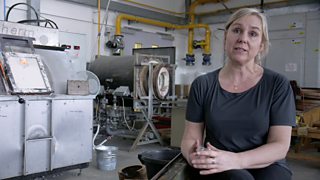A stone’s throw from the ashes of Glasgow School of Art: another Charles Rennie Mackintosh landmark, brought back to life
02 August 2018

Less than a month after the catastrophic fire that tore through Glasgow School of Art, another building designed by Charles Rennie Mackintosh reopened after years of neglect: The Willow Tea Rooms, on Glasgow’s famous Sauchiehall Street.
The ����ý Two Scotland programme Mackintosh’s Tea Room followed to their original glory.
Some of Scotland’s finest craftspeople – furniture makers, glass experts and artists – put their “life and soul” into replicating Mackintosh’s famous designs, ensuring each element of the tea rooms ended up exactly as Mackintosh had originally designed it.
Furniture maker Kelvin Murray


Kelvin loves that he can walk into the Willow Tea Rooms, look at the furniture he crafted to Mackintosh’s original specifications and say ‘I made that.’
There were, however, a few downsides to working on the project:-
“I made the call that I was going to make the tables. Looking at it though, I’m afraid I drew the short straw: I’ve got 188 small – tiny – petal details to make for the tables!”

A woodworker creates 180 perfect wooden petals details for Charles Rennie Mackintosh's chairs
A woodworker has to create perfect models of Charles Rennie Mackintosh's chairs.
Kelvin revelled in recreating the ornate chairs because of a personal connection with Mackintosh’s designs.
“When I was 15 years old, my mother decided that she, my sister and I were going on a trip to Helensburgh, where we ended up at Mackintosh’s Hill House.
“I walked into the house and the sun was shining through the windows. It was like walking into outer space — it blew me away!”

Glass technician Ingrid Phillips

Ingrid was tasked with making 200 glass shapes for the two chandeliers comprising The Willow Tea Rooms’ centrepiece.
One of the most challenging aspects of her work was including bubbles – known as seeds – inside the glass.
“As a glassmaker, I spend most of my life trying to melt glass without any seeds, so the first prototypes were without seeds that obviously were rejected.”
Although she found it “a very special project” on which to work, Ingrid admitted she was, at times, slightly daunted.
“I don’t really know how, [with] so many elements all put together, what the effect is going to be like — because no one would be crazy enough to do that these days!”

A glass blower recreates a glass ball for Mackintosh's dramatic chandelier
Creating Charles Rennie Mackintosh's luxurious chandeliers
Stained glass artist Rab Macinnes
Rab is a stained glass expert, brought on to the project because of his previous experience renovating Mackintosh designs for Windyhill in Kilmacolm, Inverclyde.

This project had a much shorter timeframe than Rab was used to; and it was difficult due to the unique nature of the designs.
“None of the things that I am designing or making can be bought off of shelves. I have less than four months to put everything together. It’s extremely daunting considering that most of the work hasn’t been done in least 100 years.”
- The tea rooms that brought Mackintosh back to life (����ý News)
Latest features from ����ý Scotland
-
![]()
'Wild swimming helps me process the grief of losing my son'
The benefits of cold water therapy.
-
![]()
Winter adventures are appealing, but an expert advises caution
Trips in winter require particular knowledge and skills.
-
![]()
The rescuers: Why volunteers risk their lives in mountain emergencies
Landward meets members of the Cairngorm Mountain Rescue Team.
-
![]()
‘Look for the light’ – practical tips to help you through another winter with SAD
Useful advice and tips to combat low moods at this time of year.
-
![]()
How you could be a binge drinker without even knowing
Binge drinking is classed as fewer units than many people may realise.
-
![]()
How chocolate biscuits and drama classes helped one man leave prison behind
The healing power of creativity.
-
![]()
'When people believe in you, it’s life-changing'
Author Graeme Armstrong revisits the man who helped turn his life around.
-
![]()
The 'breath-taking' display of US birds swept on to British soil
Recent storms have brought rare birds to our shores.
-
![]()
Six things we learned about Alan Cumming on Take the Floor (Spoiler: includes accordions)
The actor spoke to Take the Floor's Gary Innes.
-
![]()
How street gangs trap young men in a dangerous cycle of violence
The almost inescapable pull of life in a gang.
-
![]()
Why stylist Gok Wan believes there's no such thing as bad fashion
The fashion expert says we should stop following rules and do what feels right.
-
![]()
Is sending a CV still the right way to apply for a job?
They've been central to job applications for years, but are they worth it?




















